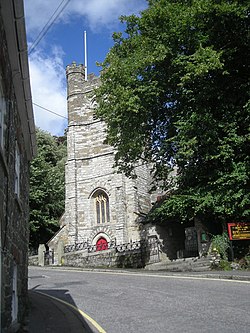St Gluvias
| St Gluvias Cornish: Bosheydhlann | |
| Cornwall | |
|---|---|
 St Gluvias Church | |
| Location | |
| Grid reference: | SW782345 |
| Location: | 50°10’19"N, 5°6’22"W |
| Data | |
| Population: | 1,505 (2011) |
| Post town: | Penryn |
| Postcode: | TR10 |
| Dialling code: | 01326 |
| Local Government | |
| Council: | Cornwall |
| Parliamentary constituency: |
Truro and Falmouth |
St Gluvias is a village in Cornwall, which has become a suburb on the northern edge of Penryn. It is to be found two miles northwest of Falmouth. The parish population at the 2011 census was 1,505.[1]
Church history
The historic parish church of St Gluvias is dedicated to Gluvias of Cornwall (or Gluviacus) and serves wider the Church of England parish of St Gluvias with Penryn.
Gluvias of Cornwall is said to have been the son of Gwynllyw the warrior, King of Gwentlog, and a nephew of St Petroc. The church was founded in the 6th century and the parish was in the Middle Ages sometimes called Behethlan or Bohelland.[2]
The present church is a recent construction by J. P. St Aubyn in 1883, though the tower is mediæval: it is made of blocks of granite. The church contains the brass of Thomas Kyllygrewe, ca. 1485.[3] There are also three wall-monuments of interest: Samuel Pendarves, d. 1693, and his wife; William Pendarves, d. 1671, and his wife (both are curiously positioned with the figures which should face each other on either side of the corners of a window opening); and J. Kempe, d. 1711, bust under drapery.[4]
The Wesleyan missionary Benjamin Carvosso was born in this parish.

Outside links
| ("Wikimedia Commons" has material about St Gluvias) |
References
- Brown, H. Miles (1945) A Cornish Incumbency, 1741-1776 (John Penrose of St Gluvias). [Wendron?]: H. M. Brown
